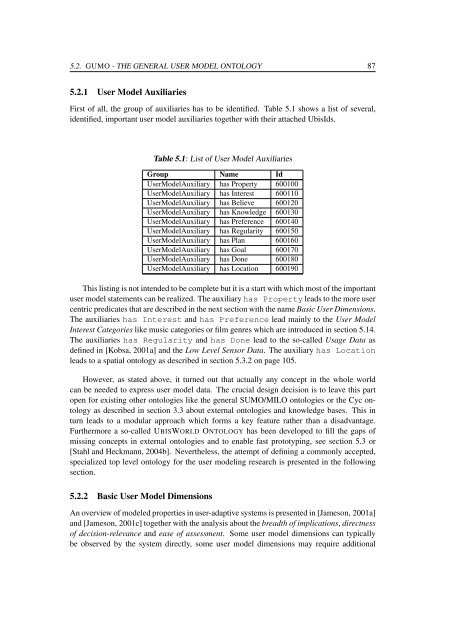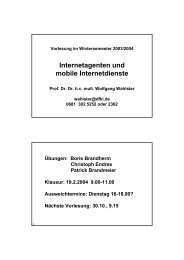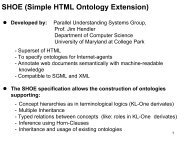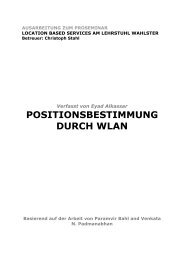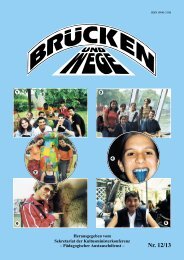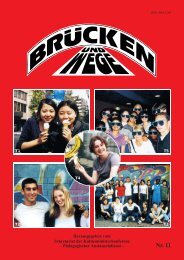heckman thesis.pdf
heckman thesis.pdf
heckman thesis.pdf
You also want an ePaper? Increase the reach of your titles
YUMPU automatically turns print PDFs into web optimized ePapers that Google loves.
5.2. GUMO - THE GENERAL USER MODEL ONTOLOGY 87<br />
5.2.1 User Model Auxiliaries<br />
First of all, the group of auxiliaries has to be identified. Table 5.1 shows a list of several,<br />
identified, important user model auxiliaries together with their attached UbisIds.<br />
Table 5.1: List of User Model Auxiliaries<br />
Group Name Id<br />
UserModelAuxiliary has Property 600100<br />
UserModelAuxiliary has Interest 600110<br />
UserModelAuxiliary has Believe 600120<br />
UserModelAuxiliary has Knowledge 600130<br />
UserModelAuxiliary has Preference 600140<br />
UserModelAuxiliary has Regularity 600150<br />
UserModelAuxiliary has Plan 600160<br />
UserModelAuxiliary has Goal 600170<br />
UserModelAuxiliary has Done 600180<br />
UserModelAuxiliary has Location 600190<br />
This listing is not intended to be complete but it is a start with which most of the important<br />
user model statements can be realized. The auxiliary has Property leads to the more user<br />
centric predicates that are described in the next section with the name Basic User Dimensions.<br />
The auxiliaries has Interest and has Preference lead mainly to the User Model<br />
Interest Categories like music categories or film genres which are introduced in section 5.14.<br />
The auxiliaries has Regularity and has Done lead to the so-called Usage Data as<br />
defined in [Kobsa, 2001a] and the Low Level Sensor Data. The auxiliary has Location<br />
leads to a spatial ontology as described in section 5.3.2 on page 105.<br />
However, as stated above, it turned out that actually any concept in the whole world<br />
can be needed to express user model data. The crucial design decision is to leave this part<br />
open for existing other ontologies like the general SUMO/MILO ontologies or the Cyc ontology<br />
as described in section 3.3 about external ontologies and knowledge bases. This in<br />
turn leads to a modular approach which forms a key feature rather than a disadvantage.<br />
Furthermore a so-called UBISWORLD ONTOLOGY has been developed to fill the gaps of<br />
missing concepts in external ontologies and to enable fast prototyping, see section 5.3 or<br />
[Stahl and Heckmann, 2004b]. Nevertheless, the attempt of defining a commonly accepted,<br />
specialized top level ontology for the user modeling research is presented in the following<br />
section.<br />
5.2.2 Basic User Model Dimensions<br />
An overview of modeled properties in user-adaptive systems is presented in [Jameson, 2001a]<br />
and [Jameson, 2001c] together with the analysis about the breadth of implications, directness<br />
of decision-relevance and ease of assessment. Some user model dimensions can typically<br />
be observed by the system directly, some user model dimensions may require additional


